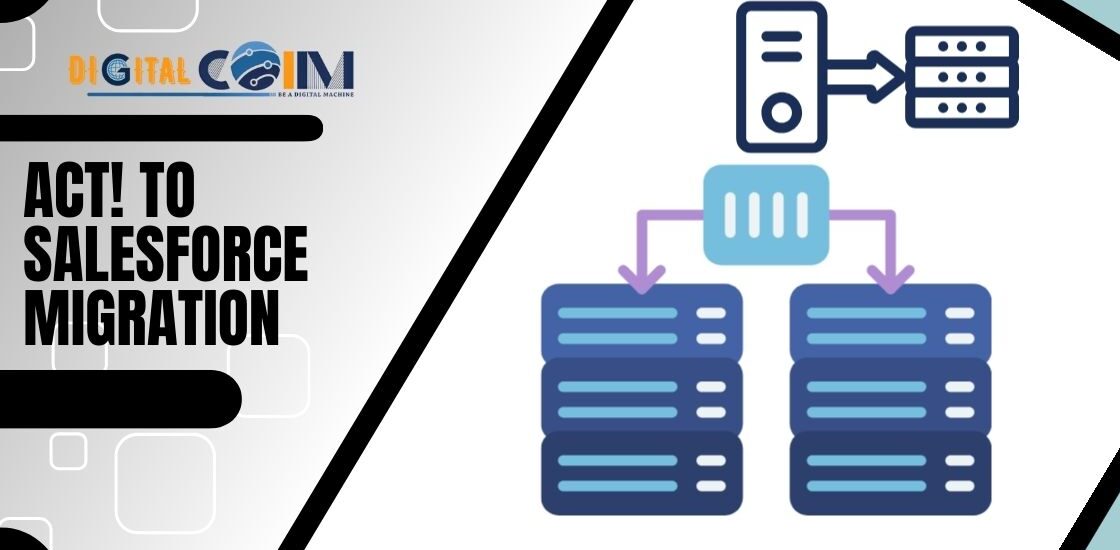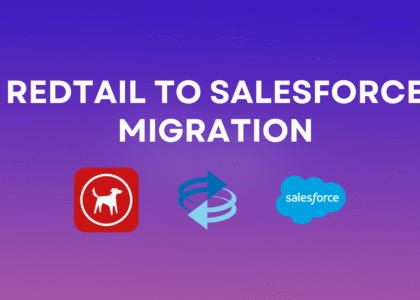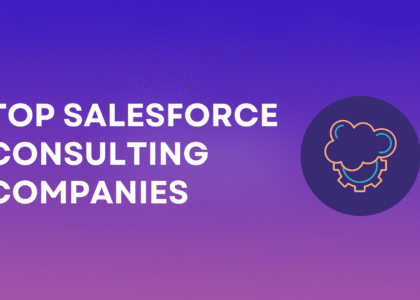Migrating from ACT! CRM to Salesforce is not just a technical project — it’s a strategic business move. ACT! has served as a trusted CRM solution for many small and medium-sized businesses for decades. It offers essential contact management and opportunity tracking features, but in today’s competitive business landscape, organizations need more than just a basic CRM.
Salesforce, on the other hand, is a cloud-based, highly customizable, AI-powered CRM that can scale from small teams to global enterprises. Its extensive automation capabilities, integration ecosystem, and real-time analytics empower sales, marketing, and service teams to deliver exceptional customer experiences.
In this comprehensive guide, we’ll break down everything you need to know about migrating from ACT! to Salesforce — including the reasons to migrate, challenges you’ll face, tools you can use, the exact migration process, best practices, cost considerations, and post-migration strategies.
1. Understanding ACT! CRM vs. Salesforce
Before you commit to migration, you need to understand how ACT! and Salesforce differ fundamentally.
| Feature | ACT! CRM | Salesforce |
|---|---|---|
| Deployment | Primarily desktop-based with limited cloud options | 100% cloud-based, accessible anywhere |
| Customization | Limited custom field creation | Deep customization via custom objects, Lightning components, and APIs |
| Automation | Basic automation workflows | Advanced automation with Process Builder, Flow Builder, and Einstein AI |
| Reporting | Basic reporting tools | Advanced, real-time, customizable dashboards |
| Integrations | Few third-party integrations | 7,000+ apps and integrations via AppExchange |
| Scalability | Best suited for small teams | Suitable for small, medium, and enterprise organizations |
Key takeaway: If your organization is growing, relies on multiple business applications, or needs robust reporting and automation, Salesforce offers unmatched advantages.
2. Why Businesses Migrate from ACT! to Salesforce
While ACT! can handle fundamental CRM needs, here’s why many businesses are making the move:
2.1 Cloud-First Accessibility
Salesforce is cloud-native, allowing secure access from any device, anywhere — perfect for remote and hybrid work environments.
2.2 Advanced Automation
Salesforce’s automation tools can streamline lead assignment, trigger follow-ups, and even predict customer behavior using AI.
2.3 Scalability Without Limits
From a 5-person startup to a 5,000-employee enterprise, Salesforce can grow with you without requiring a full system overhaul.
2.4 Rich Ecosystem of Integrations
Connect Salesforce to marketing platforms, ERP systems, payment gateways, support tools, and more.
2.5 Better Reporting and Analytics
Salesforce offers real-time dashboards, customizable reports, and forecasting capabilities.
3. Common Challenges in ACT! to Salesforce Migration
Moving CRMs is not as simple as “copy and paste.” Here are common roadblocks:
-
Data Structure Differences
ACT! and Salesforce store data differently, so field mapping is essential. -
Data Quality Problems
Old, duplicate, or missing records must be cleaned before migration. -
Custom Field Mapping
ACT! custom fields must be recreated in Salesforce. -
Preserving Historical Data
Activities, notes, and call logs need careful migration to maintain relationship context. -
User Adoption Issues
Without training, teams may struggle to adapt to the new system.
4. Step-by-Step ACT! to Salesforce Migration Process

Step 1 – Project Planning
-
Define your business goals for migration (e.g., better reporting, automation, integration).
-
Decide whether you’ll migrate all historical data or only active records.
-
Assign responsibilities — project manager, technical lead, data owner, Salesforce admin.
-
Choose migration tools (Salesforce Data Loader, Jitterbit, Skyvia, DemandTools).
Step 2 – Data Assessment & Cleanup
-
Export a sample dataset from ACT! for review.
-
Remove duplicates, outdated records, and incomplete entries.
-
Standardize formats (e.g., phone numbers, emails).
-
Archive old data you don’t need in Salesforce.
Step 3 – Field Mapping
Map ACT! fields to Salesforce standard/custom fields:
-
ACT! “Company” → Salesforce “Account”
-
ACT! “Contact” → Salesforce “Contact”
-
ACT! “Opportunity” → Salesforce “Opportunity”
-
ACT! “Notes/History” → Salesforce “Activities/Notes”
Step 4 – Data Extraction
-
Use ACT!’s export tool to get CSV/Excel files for each record type.
-
Keep separate files for Accounts, Contacts, Opportunities, and Activities.
-
Create a secure backup before proceeding.
Step 5 – Data Transformation
-
Apply mapping rules.
-
Ensure relationships are maintained (link contacts to the correct account).
-
Convert date and currency formats to Salesforce’s requirements.
Step 6 – Data Import
-
Import in the correct order: Accounts → Contacts → Opportunities → Activities.
-
Use Salesforce Data Loader for large volumes.
-
For complex migrations, use Jitterbit or Skyvia for ETL (Extract, Transform, Load).
Step 7 – Testing & Validation
-
Compare record counts.
-
Validate data relationships.
-
Run test reports to ensure accuracy.
Step 8 – User Training & Go-Live
-
Provide Salesforce training tailored to user roles.
-
Share quick reference guides.
-
Offer real-time support in the first few weeks.
5. Tools for ACT! to Salesforce Migration
| Tool | Best For | Pros | Cons |
|---|---|---|---|
| Salesforce Data Loader | Free, bulk imports | Secure, fast, supports large volumes | Requires technical knowledge |
| Jitterbit Data Loader | Automation | Easy scheduling, drag-and-drop mapping | Paid tool |
| Skyvia | Cloud-based migrations | No-code, user-friendly | Limited customization in free plan |
| DemandTools | Data cleaning + migration | Advanced data quality control | Learning curve |
6. Best Practices for a Smooth Migration
-
Start in a Sandbox – Test migration in a non-production environment first.
-
Migrate in Batches – Avoid importing all data at once.
-
Document Everything – Keep a record of field mappings and transformations.
-
Focus on Data Quality – Don’t transfer junk data.
-
Plan for Change Management – Encourage adoption with training and incentives.
7. Post-Migration Optimization
Migration isn’t the end — it’s the beginning of maximizing Salesforce ROI.
-
Automation Setup – Build workflows to automate repetitive tasks.
-
Integration with Marketing Tools – Connect Salesforce to Pardot, HubSpot, or Mailchimp.
-
Custom Dashboards – Tailor views for sales, marketing, and service teams.
-
Mobile Access – Enable Salesforce mobile app for field teams.
-
Ongoing Data Maintenance – Regular deduplication and cleanup.
8. Estimated Timeline & Cost
| Business Size | Timeline | Cost Range |
|---|---|---|
| Small Business | 2–4 weeks | $3,000–$7,000 |
| Medium Business | 1–2 months | $8,000–$15,000 |
| Large Enterprise | 2–3 months | $20,000+ |
Cost Factors:
-
Data complexity
-
Historical data volume
-
Integrations
-
Customization needs
9. Real-World Migration Example
A B2B technology company with 50 employees migrated from ACT! to Salesforce to improve lead tracking and automate follow-ups.
Before migration:
-
Leads were tracked manually.
-
Reports took hours to compile.
-
No mobile access for sales reps.
After migration:
-
Leads auto-assigned to sales reps within seconds.
-
Real-time dashboards show sales performance.
-
Mobile CRM increased productivity by 25%.
10. FAQs
Q1: Can I migrate ACT! notes and history to Salesforce?
Yes, they can be mapped to Salesforce Activities and Notes.
Q2: Will migration cause downtime?
With proper planning, downtime is minimal, often done outside business hours.
Q3: Do I need a consultant?
For simple migrations, you can use built-in tools. For complex cases, a Salesforce-certified partner is recommended.
Q4: What if I have custom fields in ACT!?
Create matching custom fields in Salesforce before migration.
11. Conclusion
Migrating from ACT! to Salesforce is more than moving data — it’s transforming your customer relationship strategy. By following a structured process, using the right tools, and focusing on user adoption, you can make the transition smooth and unlock the full potential of Salesforce.
Whether you do it in-house or with a migration partner, the investment pays off in efficiency, scalability, and customer satisfaction.






